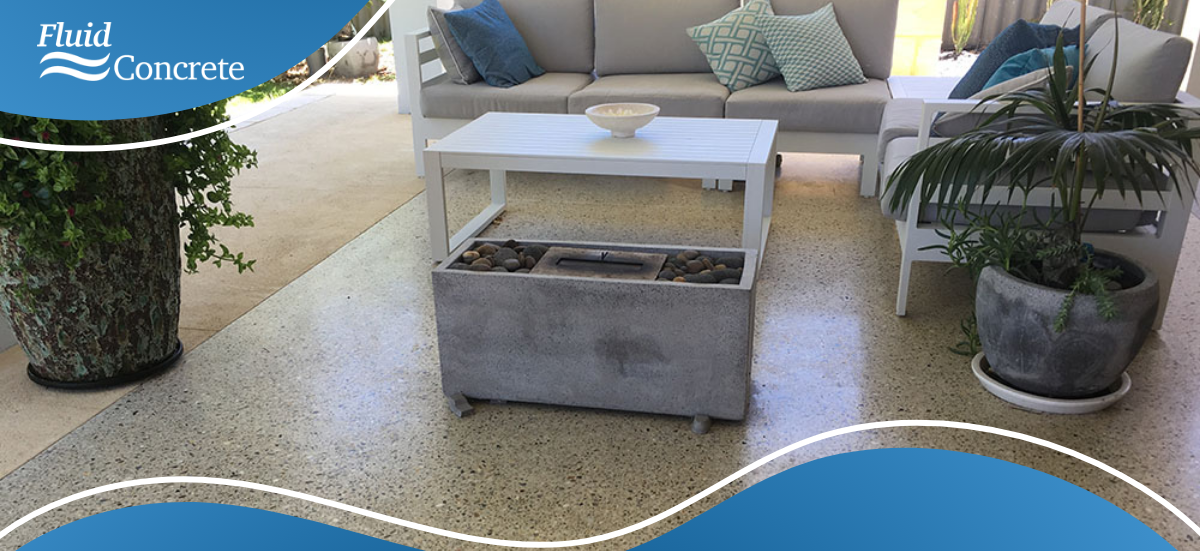How to Choose the Right Color for Your Honed Concrete Floors

The Role of Colour and Pattern in Honed Concrete Finishes
January 16, 2023
The durability of exposed aggregate in harsh weather conditions
July 13, 2023In this article, we will introduce the reader to the concept of honed concrete flooring and talk about the options available when it comes to colouring the finish to match any existing designs and colour schemes.
While we highly recommend you engage the services of a honed concrete specialist like Fluid Concrete to apply this method to your own space, a skilled DIY enthusiast can achieve decent results with the right tools and know-how. We will give some tips and advice on how to apply colour and eye-catching design to honed concrete floors for the plucky amateur who wants to tackle the challenging world of aggregates and honed concrete.
What is honed concrete?
Concrete containing exposed aggregates like small stones and other materials has been popular for several years and not without good reason. It is incredibly versatile, hard-wearing, and attractive. Exposed aggregate tends to have a rough surface where the objects encased in the concrete protrude slightly once the top layer of mortar has been scrubbed away. This has the effect of not only making it look great but also of providing traction underfoot in areas that benefit from the reduced risk of slipping.
Honed concrete is the next step up the ladder from exposed aggregate in terms of the finished result. It follows exactly the same process up to the point where the concrete sets. The surface is then ground or ‘honed’ using a commercial concrete grinder, removing all of the imperfections in the surface. This serves to polish the top of the aggregate that was left exposed and the results are spectacular once a surface sealant is applied. Honed concrete is truly impressive to behold once the polishing is completed and is just as strong and durable as its predecessor.
How to apply colour and eye-catching design to honed concrete floors
If you are boldly creating your own honed concrete surface then there are several things you can do to add colour and stylish design touches to the finished surface. The main thing providing colour to the final result is the nature of the aggregate itself. It is possible to introduce almost any objects into the concrete mixture that can be sealed therein and revealed later once the grinding is completed. Limits of dimension aside, imagination is the only real boundary when it comes to choosing your aggregate but some popular choices include:
- Crushed stone
- Stone pebbles
- Basalt
- Quartz
- Crushed glass
- Glass pebbles
- Seashells
There is no reason why you couldn’t make use of almost any attractive, sturdy material that will be sealed in and thus protected.
Creating graphic designs
It is also possible to create specific designs and artwork on your exposed aggregate before the final sealing is completed. Graphic designs can be produced in a variety of ways including:
- Cutting into the surface
- Using speciality tape to mask areas off
- Stamping
- Stenciling
All of these methods are used in conjunction with the introduction of different coloured acid stains and acetone dyes. The lighter the original surface of the exposed aggregate, the more effective this will be but there is also something to be said for the subtle effects dyes can have on darker surfaces. This is where your individual colour scheme and preferences come into play and you can really express yourself artistically with practice.
Acid stains
Acid stains attack the concrete itself and open up pores that metallic salts in the solution work their way into. The resulting chemical reaction between the salts and the existing lime in the concrete causes the colour to change permanently, generally to an earthy colour with a mottled appearance not dissimilar to marble.
Acetone dyes
Previous incarnations of these dyes did not cause chemical reactions within the concrete itself to permanently change the colour but modern versions are ever more advanced. They allow much deeper penetration and the dye molecules are driven into the concrete pores. This allows for a much wider range of colour options than the acid stains, opening up a whole new world of design and style choices that were previously impossible to create.
With any of these techniques, it is essential to experiment before applying the substances to your lovingly crafted and poured exposed aggregate. Acid stains do not respond like traditional colours, it is not possible to simply mix them and expect the colours to come out the same way they would with art supplies. Acetone dyes are more easily predicted but the colour of the original concrete is a huge factor in the eventual outcome.
A note of caution
Acetone is a form of solvent and is exceptionally flammable. It must be handled with caution at all times and all the instructed safety equipment must be used to reduce the risk of injury.
Final tips
It pays to remember that when producing honed concrete, the final step before sealing is grinding the surface until it is smooth and flawless. Any shallow cuts or areas of colour that do not penetrate deeply enough will simply be ground away and disappear once you start this final process. Testing is the key to success with such a hit-and-miss process and your chances of achieving the results you dream of are drastically increased the more experimentation you can do beforehand.
Contact us
This is an extremely challenging, awkward process and the best solution is to turn to experts like Fluid Concrete to guarantee the results you want. Please contact us when you are ready and discuss your ideas and design concepts with our team of experts. We will gladly give you any advice and a free, zero-obligation quote for the job you have in mind.




